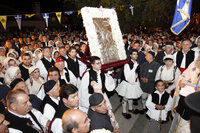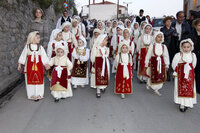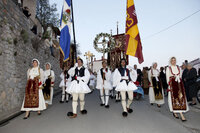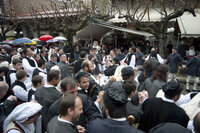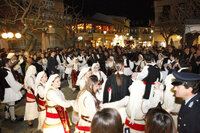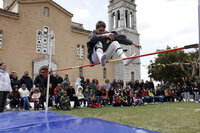St George Celebration
Events - Programme 2015
General Information
“Panigyraki” is a three day, mostly religious, celebration in honor of the Great Martyr Saint George the
Trophy-Bearer who is also the patron saint of Arachova. According to the Orthodox Greek Church, his
memory is commemorated on the 23rd of April. However, this commemoration is postponed until the second day after Easter if Easter is celebrated after the 23rd of April of that year.
Yet, in order to understand better the facts presented beforehand, there needs to be mentioned that apart from the three-day celebration, “Panigyraki” is also called the local symbolic song, analysed in a different unit, as well as the local dance related to the specific song. Moreover, the celebration is inexorably interwoven with the Easter spirit, the joy that it brings to Greeks and Christians in general and as it is expected it lends colour to the celebration. In addition, the spring weather gives the participants of the festival the opportunity to come closer to the events, presented further down, most of which take place on the surroundings of the Holy Temple right after the daily Divine Liturgy. The festival also depends on the relationship between the Saint and Arachova and far and foremost on the protection he has offered to both living humans and the village in general, literary saving it for a number of times in the past, when confronted with extreme dangers and problems. At this point, it should be stressed that the “Battle of Arachova” was of extreme importance for the Greek nation. In the battle, which took place in November 1826 a few metres away from the churchyard, General Georgios Karaiskakis triumphed over the Ottoman occupiers of Greece pleading for Saint George’s help, patron of the village.
The Holy Church of Saint George in Arachova is one of the two parish churches in the village and it is
prominently located on the top of the village, on the foothills of Parnassus Mountain. You can easily reach the church on foot by climbing up the steps the bottom of which is on the central street of Arachova. However, there are other more time consuming but less tiring routes to be followed in order to get to the church. Even though car access is feasible, it should probably be avoided due to congestion. There is a small outdoor open air parking space and a special ramp for people facing any kind of difficulty.
Events
The origins of the worship of Saint George are lost in the depths of time. “Panigyraki” is considered to be another kind of Easter for the locals as far as preparations, celebrations, hospitality and mostly magnificence are concerned!!!
Eve of the Festival— Vespers, Procession of the Holy Icon of Saint George
The vespers begin in the afternoon of the festival’s Eve, after the first cannon fire and the festive church
bell-tolling. Thousands of people come to honor Saint George. Every and each local as well as visitors either Greek or from abroad light a candle on Saint George’s memory and experience the authentic traditional Greek-Orthodox spirit of the celebration. Suddenly at about 5 o’clock in the afternoon, all the roads and the narrow streets of the village are full of people heading towards the temple, which is also the centre of the celebrations.
Arachova is overcrowded by thousands of worshippers at that time. Even passers-by will get to reschedule their program and remain to the village even for a little longer, when they face such greatness and emotion. Hundreds of local people but also visitors, who have once felt this thrill of elation and devoutness during the unique moment of the procession of the Holy Icon, head towards the church dressed in traditional local costumes, either inherited to them by their ancestors or made in our days by people who are sufficiently versed in the secrets of tradition, safely guarded only for occasions like this.
The first ones to arrive in the grounds of the church dressed in traditional costumes along with the older men will sing out loud and dance to “Panigyraki”, accompanied by the sounds of “pipiza” (a traditional local woodwind instrument). The specific event also known as the “Dancing by the olders” (the old men), takes place before the vespers! The vespers will not take a long time because it follows the procession of the holy icon around the village. Logically speaking, the space in the temple and its courtyard cannot host that many people so most of the participants wait along the route and gradually join in the procession on its way through the streets. The Clergy, chanters, bands, the army, bell-tolling, cannon-fire, incense local women burn out of their houses, which are beautifully decorated with flags and traditional local carpets placed on the balconies, compliment the Byzantine pomp and circumstance one of the most important saints of Orthodoxy certainly deserves. However, what literary adorns the cortege and takes your breath away is the two thousands of people (sometimes even more) dressed in their traditional local costumes who lead the procession. “Foustanelles” and “kamzoles” are worn by men and “sigounia” by women. In two lines, formed on the left and the right side of the street accordingly, one after another, without making any sound or unnecessary movements, they faithfully make way for the Icon. People of all ages ranging from three-yearold children to ninety-year-old people, each and every of them dressed in costumes, take part in the procession. The procession lasts for about two hours and reaches the church at around nine o’clock in the evening. The vespers end and the whole crowd climbs down the stone steps that lead to the central street so as to continue celebrating and dancing in the central square, without the use of any microphones or effects, just by the sounds of “pipiza” and “daoulia” (tradition percussion instrument). A Greek sound, an ancient sound.
The next day follows Divine Liturgy but also the eminent sporting custom “Uphill race for olders” while
outdoors in the open-air of every road and narrow street of the village, neighbours roast the traditional meal, lamp on the spit, according to the customs of both the village and Easter. The celebration is always about having a good time, as well.
First Day — Uphill race for the olders, Performance at the fountain of Saint George
First thing in the morning there will be cannon-fires, followed by a bugle call and of course, church belltolling announcing the morning Divine Liturgy. It is time for the Matins and Divine Liturgy to the church of Saint George. Starting from today and for the following couple of days thousands of people, locals, visitors and passers-by, who have found out about the festival by chance, will pay a visit to the temple in order to light a candle to honor the Saint.
Uphill Race
Right after the Divine Liturgy, it is time for the sporting customs! Every day at the exact same time both
locals and visitors dressed either in local traditional costume or sport clothes enter their names for one or more of the sporting customs, organised in the grounds of the Temple the following days. All of the
participants are usually relatively young. However, in one of these sporting events, the first one to be held, the starring figures happen to be the elderly men rather that young boys and men. Men over sixty years old take part in the “Uphill Race for olders”. The old man Mistos Mitalas gave up this effort when he was ninety years old, having won a lot of bronze and silver medals and of course an outstanding number of gold ones, being awarded with a lamb. Lambs are offered by the local shepherds as prizes to the winners. There are two more uphill races following the first one. All of the uphill races are held in the historic battlefield which is near the churchyard, just a few metres above the most remote houses on the upper side of the village, right on the foothills of Parnassus Mountain. In the next two uphill races younger men and children take part. After the end of the races the group of the winners returns back to the courtyard of the temple accompanied by crowds of people under the sound of “pipiza” and “daouli”, getting ready for the next custom.
Perfomance at the Fountain of St. George
The origins of the pictures generated by the lines of the symbolic and allegoric “Panigyraki” are lost in the depths of time. Some of the song lines are:
The Dragon guards the water, the festival is thirsty
The mules yearn for water and the spirits die of thirst
Three slender girls get together to go and tell the Dragon
“Release the water, oh Dragon!”
While the group with the winners of the uphill races heads for the church, it suddenly stops a few steps away from it, at the stone fountain, singing “Panigyraki” at the same time. As soon as the line “Release the water, oh Dragon!” is uttered, water flowing directly from the natural springs of Parnassus Mountain starts pouring out of the fountain.
As it has been aforementioned, a great importance is given to both folk songs and dances during the
celebration.
The 5000 Metres Race
It is worth mentioning that in the afternoon, during the first day of the celebration, a 5000 m. race is held. The athletes’ starting point is in Saint Minas, a chapel located out of the village on the way towards Delphi, and the finishing point is set at Lakka square. The race ends at around 7.30 in the evening. Folk dances performed by the Traditional Association dance group of Arachova come up next.
SECOND DAY — Sporting customs: long jump and triple jump, high jump, rock-lifting.More sporting customs such as standing long jump, long jump and triple jump, rock-lifting and high jump
are to be held during the second day after Divine Liturgy. Participants can either be dressed in traditional local costumes or not. As usual, the events take place in the courtyard of the Temple and the winning prizes remain medals for the first three winners and a lamb to be awarded only to the gold winner. Given the fact that at this time of year there is probably going to be fine weather you may want to seize the opportunity of enjoying a cup of coffee or some tsipouro (local alcoholic beverage) in the sun at one of the local restaurants and cafes.
In the evening, there is usually a folk band, composed by well-known artists and excellent musician, hosted by the organizing committee of the celebrations. The fest is held in one of the central squares and it gives everyone the opportunity to savour the Arachovian tradition and hospitality and become part of it.
THIRD DAY — Sporting customs: stone-throwing, wrestling, tug-of-war, banquet (“chalasma”).
This last day of the festival also starts by attending Divine Liturgy, followed by a memorial service for the heroes of the battle of Arachova. Held at the monument dedicated to George Karaiskakis, which is also located in the churchyard, the memorial service gives its turn to the following sporting customs: shot put, stone-throwing, wrestling and last but not least tug-of-war, wearing traditional local costumes or not.
Chalasma
At 3 o’clock in the afternoon cannon-fires and church bell-tolling call the crowd once more to the grounds of the church, in order to take part in “chalasma”, the feast which will mark the end of the celebrations for another year. At the courtyard there has been set a table for everyone, locals and visitors alike, full of roasted lambs, prepared in the morning of the exact same day, wine and other viands. Participants, most of them wearing a local traditional costume, arrive gradually to glorify this day once more. Of course you should feel free to join in the feast even if you are not dressed in “foustanelles” or “sigounia”. The complimentary meal is provided by the municipality and the local church. This is the time to get together and eat, drink and dance while listening to poems and stories written by our ancestors. Moreover, we shall sing “kleftika” (folk) songs appropriately harmonized with the day and location. These songs are widely known as “songs of the tavla”, named after the fact that they are performed when being around a “tavla”, a mutual meal.
After the participants have tasted the delicious food and sung to folk songs, the next and last event of the feast starts. All the participants shall rise and form a giant circle, having the priest of the village as a leader. The crowd will go round the Temple slowly dancing “Panigyraki” hand by hand. The ceremonial dance calls for three rounds to have been completed before the crowd climbs down the steps, while at the background there is the sound of traditional musical instruments, cannon-fires and fusillade.















